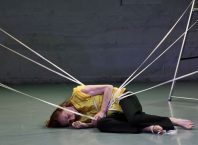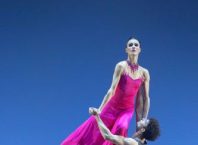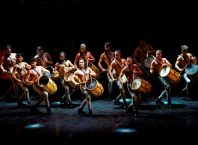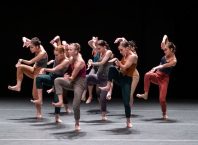There is a community of movement in Batsheva’s Varda Studio at the Suzanne Dellal Centre in Tel Aviv. Yesterday, as Artistic Director Ohad Naharin and Executive Director Dina Eldor announced plans for the upcoming 2012 – 2013 season, dancers and guests sat together on low benches on all four sides of the room, for a town meeting in which the most important statements are made without words.
It began almost imperceptibly, first one male dancer rose from the bench, then another man and woman. More dancers join in, one sliding backwards from the bench onto the floor. Dream like slow movements suddenly exploding into action, each moment different, fresh, unexpected. This exquisitely choreographed chaos teases images and associations from the mind. Flashes of familiar sequences play out to an ever-changing soundtrack, sometimes in ironic contrast to the choreography: Danny Kaye sings “Inchworm” in a gentle voice as dancers pound the air with their fists; the poetic sequence from Ohad Naharin’s Sadeh 21, the dancers joining hands and dancing in a slow, almost ceremonial circle to the theme song from “It’s About Time” (a US tv series 1966 – 67).
At one point the dancers all moved slowly forward in unison, looking around with eyes wide, their slow progression and expressions creating a sense of wonder and discovery somehow merged with wary anticipation. Then the moment dissolved and opened up into disparate movement. Each choreographic sequence setting a trajectory of images and associations into play – at almost any given moment, there is not one story, but many.
This is the experience of Session by Ohad Naharin in collaboration with the Batsheva Dancers. The work was first performed as a dance installation at the Fondation Beyeler in Basel in November 2011. It’s a wonderful game with simple rules, as Naharin explained to the guests in the studio: “The dancers are allowed to quote everything from the repertoire that they know. It is based on their decisions.” In other words, the performance is not at all improvised, everything that takes place is taken from Ohad Naharin’s choreographic repertoire; yet at the same time, within those boundaries, the dancers have complete freedom to choose. It is an arena in which anything can happen; watching the dancers, their awareness of one another is palpable, all senses alert, the energy in the room is contagious.
The meeting of movement and music, eclectic, exciting and often in surprising and unexpected configurations, is under the sure hand of DJ Guy Shomroni, formerly a dancer in the Bat Sheva Company. According to Naharin, in performances of Session, Shomroni is “totally free” to choose the music at will. Later, chatting with Shomroni, he explained that he is always searching and listening to a wide variety of music, creating a continually updated vast reservoir to draw upon during performances. Shomroni is also working on the music for a new dance piece that Naharin will be creating for the company, and said that Session is like a “playground for researching the soundtrack for the new work on the dancers. I can try things out and see how it plays and we discuss it later.”
Later, chatting with dancers Iyar Elezra and Chen-Wei Li, it was clear that performing Session is a lot of fun for the dancers as well. When I asked them whether having to make decisions in real-time in front of an audience might feel a bit scary, Iyar explained that as Naharin works with the company through Gaga, one of the main tenets of this movement language is to be always “available for movement” – in other words: ready for anything.
In addition to Session, the Batsheva 2012 – 2013 season will include a dance piece choreographed by Hofesh Schecter, a new work for the Bat Sheva Ensemble choreographed by former Batsheva dancer Danielle Agami, and a new work for the company choreographed by Ohad Naharin. Batsheva has recently experienced a significant turn-over in both the company and the ensemble and are welcoming several new dancers as the season begins. Naharin said, “It’s a bonding time for us.”





